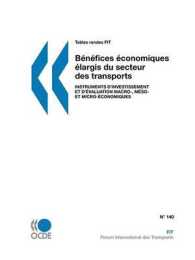- ホーム
- > 洋書
- > 英文書
- > Religion / Ethics
Full Description
ALERTcourse syllabus to ensure that you select the correct ISBN. Several versions of Pearson's MyLab & Mastering products exist for each title, including customized versions for individual schools, and registrations are not transferable. In addition, you may need a CourseID, provided by your instructor, to register for and use Pearson's MyLab & Mastering products. Packages Access codes for Pearson's MyLab & Mastering products may not be included when purchasing or renting from companies other than Pearson; check with the seller before completing your purchase. Used or rental books If you rent or purchase a used book with an access code, the access code may have been redeemed previously and you may have to purchase a new access code. Access codes Access codes that are purchased from sellers other than Pearson carry a higher risk of being either the wrong ISBN or a previously redeemed code. Check with the seller prior to purchase. -- This access code card gives you access to all of MyReligionLab's tools and resources, including a complete eText of your book.You can also buy immediate access to MyReligionLab with Pearson eText online with a credit card at www.myreligionlab.com. Modern religions in today's changing world Living Religions emphasizes the personal consciousness of believers and their own accounts of their religion and relevance in the present day. Mary Pat Fisher considers how the contemporary beliefs and practices of each of these traditions has evolved, and explores the changing nature of each religion. The ninth edition focuses on cultural customs, popular spiritual practices, mixtures of religions, and varieties of religions ways. Expanded coverage of women, including women's voices and contributions, is woven into the discussion of each religion. Living Religions provides a sympathetic approach to the historical teachings of traditional faiths, indigenous religions, and new religious movements. The text follows a clear and straightforward account of the development, doctrines, and practices of the major faiths followed today. MyReligionLab is an integral part of the Fisher program. Key learning applications include MyReligionLibrary, Closer Look tours, and a personalized study plan.A better teaching and learning experience This program will provide a better teaching and learning experience-for you and your students. Here's how: *Personalize Learning - MyReligionLab is an online homework, tutorial, and assessment program. It helps students prepare for class and helps instructors gauge individual and class performance. *Improve Critical Thinking - Review questions throughout the text encourage readers to think critically about religion. *Engage Students - Diverse stories and cultural images bring religion to life. *Support Instructors - The most comprehensive set of instructional materials available, instructor resources reinforce and enliven the study of world religions.
Contents
In this SectionChapter 2: Indigenous Sacred Ways Chapter 3: Hinduism Chapter 4: Jainism Chapter 5: Buddhism Chapter 6: Daoism and Confucianism Chapter 7: Shinto Special Section: Zoroastrianism Chapter 8: Judaism Chapter 9: Christianity Chapter 10: Islam Chapter 11: Sikhism Chapter 12: New Religious Movements Chapter 13: Religion in the Twenty-first Century to define religion Why are there religions? Understandings of Sacred Reality Ritual, symbol, and myth Absolutist and liberal responses to modernity The encounter between science and religion Women in religions Negative aspects of organized religions Lenses for studying religions Chapter 2: Indigenous Sacred Ways Understanding indigenous sacred ways Cultural diversity The circle of right relationships Spiritual specialists Group observances Globalization Development issues Chapter 3: Hinduism Philosophical and metaphysical origins Major philosophical systems Religious foundations and theistic paths The Hindu way of life Hinduism in the modern world Chapter 4: Jainism The Tirthankaras and ascetic orders Freeing the soul: the ethical pillars Spiritual practices World Jainism Chapter 5: Buddhism The life and legend of the Buddha The Dharma Branches of Buddhism Buddhism in the West Socially engaged Buddhism Chapter 6: Daoism and Confucianism Ancient traditions Daoism - the way of nature and immorality Confucianism - the practice of the virtue Chapter 7: Shinto The roots of "Shinto" Buddhist, Daoist, and Confucian influences State Shinto "Sect Shinto" Shinto today Zoroastrianism Chapter 8: Judaism A history of the Jewish people Torah Sacred practices Holy days Contemporary Judaism Chapter 9: Christianity Historical evidence Evidence of the Bible The life and teachings of Jesus The early Church Church administration Intellectual revival and monasticism Medieval mysticism The Protestant Reformation The Roman Catholic Reformation Liberal trends The Second Vatican Council The Orthodox world today Central beliefs in contemporary Christianity Sacred practices Contemporary trends Chapter 10: Islam Pre-Islamic Arabia The Prophet Muhammad The Qur'an The central teachings The Five Pillars Sunni and Shi'a Sufism The spread of Islam Relationships with the West Muslim resurgence Chapter 11: Sikhism Guru Nanak The succession of Gurus Central beliefs Sacred practices Sikhism today Chapter 12: New Religious Movements Social context for new religious movements Charismatic leadership Offshoots of older religions Combinations of older religions Universalism Social trends Opposition to new religious movements Will new religious movements last? Chapter 13: Religion in the Twenty-first Century Globalization Secularism Religious pluralism Religion in politics Interfaith movement Religion and social issues Religion and materialism Religion and the future of humanity








